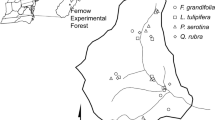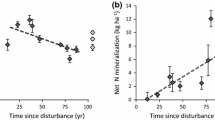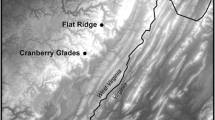Abstract
Key message
For long-term environmental investigations, tree-ring δ 15 N values are inappropriate proxies for foliar δ 15 N for both Fagus sylvatica and Picea abies under moderate N loads.
Abstract
Currently it is unclear whether stable nitrogen isotope signals of tree-rings are related to those in foliage, and whether they can be used to infer tree responses to environmental changes. We studied foliar and tree-ring nitrogen (δ15N) and carbon (δ13C) isotope ratios in European beech (Fagus sylvatica L.) and Norway spruce (Picea abies L.) from six long-term forest monitoring sites in Switzerland together with data on N deposition and soil N availability, as well as a drought response index over the last two decades. For both species, tree-ring δ15N and δ13C values were less negative compared to foliar δ15N and δ13C values, most likely due to recycling and reallocation of N within the tree and fractionation processes associated with the transport of sucrose and the formation of tree-rings, respectively. Temporal trends recorded in foliar δ15N were not reflected in tree-ring δ15N, with much higher variations in tree-rings compared to foliage. Soil N availability and N deposition were partially able to explain changes in foliar δ13C, while there were no significant correlations between environmental variables and either tree-ring or foliar δ15N. Our results suggest an uncoupling between the N isotopic composition of tree-rings and foliage. Consequently, tree-ring δ15N values are inappropriate proxies of foliar δ15N values under low-to-moderate N deposition loads. Furthermore, at such low levels of deposition, tree-ring δ15N values are not recommended as archives of tree responses to soil C/N or bulk N deposition.



Similar content being viewed by others
References
Aber J, McDowell W, Nadelhoffer K, Magill A, Berntson G, Kamakea M, McNulty S, Currie W, Rustad L, Fernandez I (1998) Nitrogen saturation in temperate forest ecosystems—hypotheses revisited. Bioscience 48:921–934
Ammann M, Siegwolf R, Pichlmayer F, Suter M, Saurer M, Brunold C (1999) Estimating the uptake of traffic-derived NO2 from 15N abundance in Norway spruce needles. Oecologia 118:124–131
Badeck F-W, Tcherkez G, Nogués S, Piel C, Ghashghaie J (2005) Post-photosynthetic fractionation of stable carbon isotopes between plant organs—a widespread phenomenon. Rapid Commun Mass Spectrom 19:1381–1391
Bengtsson G, Bengtson P, Månsson KF (2003) Gross nitrogen mineralization-, immobilization-, and nitrification rates as a function of soil C/N ratio and microbial activity. Soil Biol Biochem 35:143–154
Brooks JR, Flanagan LB, Buchmann N, Ehleringer JR (1997) Carbon isotope composition of boreal plants: functional grou** of life forms. Oecologia 110:301–311
Bukata AR, Kyser TK (2007) Carbon and nitrogen isotope variations in tree-rings as records of perturbations in regional carbon and nitrogen cycles. Environ Sci Technol 41:1331–1338
Cernusak LA, Tcherkez G, Keitel C, Cornwell WK, Santiago LS, Knohl A, Barbour MM, Williams DG, Reich PB, Ellsworth DS, Dawson TE, Griffiths HG, Farquhar GD, Wright IJ (2009) Why are non-photosynthetic tissues generally 13C enriched compared with leaves in C3 plants? Review and synthesis of current hypotheses. Funct Plant Biol 36:199–213
Cherubini P, Innes JL (2000) Switzerland: The Swiss Long-Term Forest Ecosystem Research Programme. In: Gosz JR, French C, Sprott P, White M (eds) The International Long Term Ecological Research Network, 2000 Perspectives from Participating Networks. US long term ecological research network office, University of New Mexico, Albuquerque, NM, pp 56–59
Cook ER (1985) A time series approach to tree-ring standardization. University of Arizona, Tucson
Cook ER, Kairiukstis LA (1990) Methods of dendrochronology—applications in the environmental sciences. Kluwer Academic Publishers, Dordrecht
Craine JM, Elmore AJ, Aidar MPM, Bustamante M, Dawson TE, Hobbie EA, Kahmen A, Mack MC, McLauchlan KK, Michelsen A, Nardoto GB, Pardo LH, Penuelas J, Reich PB, Schuur EAG, Stock WD, Templer PH, Virginia RA, Welker JM, Wright IJ (2009) Global patterns of foliar nitrogen isotopes and their relationships with climate, mycorrhizal fungi, foliar nutrient concentrations, and nitrogen availability. New Phytol 183:980–992
Dawson TE, Mambelli S, Plamboeck AH, Templer PH, Tu KP (2002) Stable isotopes in plant ecology. Annu Rev Ecol Syst 33:507–559
de Vries W, Du E, Butterbach-Bahl K (2014) Short and long-term impacts of nitrogen deposition on carbon sequestration by forest ecosystems. Curr Opin Environ Sustain 9–10:90–104
Di Matteo G, Perini L, Atzori P, De Angelis P, Mei T, Bertini G, Fabbio G, Scarascia-Mugnozza G (2014) Changes in foliar carbon isotope composition and seasonal stomatal conductance reveal adaptive traits in Mediterranean coppices affected by drought. J For Res 25:839–845
Eilmann B, Buchmann N, Siegwolf R, Saurer M, Cherubini P, Rigling A (2010) Fast response of Scots pine to improved water availability reflected in tree-ring width and δ13C. Plant Cell Environ 33:1351–1360
Elhani S, Guehl JM, Nys C, Picard JF, Dupouey JL (2005) Impact of fertilization on tree-ring δ15N and δ13C in beech stands: a retrospective analysis. Tree Physiol 25:1437–1446
Erisman JW, van Grinsven H, Grizzetti B, Bouraoui F, Powlson D, Reis S (2011) The European nitrogen problem in a global perspective. In: Sutton MA, Britton C, Erisman JW, Billen G, Bleeker A, Greenfelt P, van Grinsven H, Grizzetti B (eds) The European nitrogen assessment. Cambridge University Press, Cambridge, pp 9–31
Evans RD (2001) Physiological mechanisms influencing plant nitrogen isotope composition. Trends Plant Sci 6:121–126
Francey RJ, Allison CE, Etheridge DM, Trudinger CM, Enting IG, Leuenberger M, Langenfelds RL, Michel E, Steele LP (1999) A 1000-year high precision record of δ13C in atmospheric CO2. Tellus B 51:170–193
Fritts HC (1976) Tree rings and climate. Academic Press, London
Galloway JN, Townsend AR, Erisman JW, Bekunda M, Cai Z, Freney JR, Martinelli LA, Seitzinger SP, Sutton MA (2008) Transformation of the nitrogen cycle: recent trends, questions, and potential solutions. Science 320:889–892
Garten CT (1993) Variation in foliar 15N abundance and the availability of soil nitrogen on Walker Branch watershed. Ecology 74:2098–2113
Gebauer G, Schulze ED (1991) Carbon and nitrogen isotope ratios in different compartments of a healthy and a declining Picea abies forest in the Fichtelgebirge, NE Bavaria. Oecologia 87:198–207
Gerhart L, McLauchlan K (2014) Reconstructing terrestrial nutrient cycling using stable nitrogen isotopes in wood. Biogeochemistry 120:1–21
Gessler A, Schneider S, Von Sengbusch D, Weber P, Hanemann U, Huber C, Rothe A, Kreutzer K, Rennenberg H (1998) Field and laboratory experiments on net uptake of nitrate and ammonium by the roots of spruce (Picea abies) and beech (Fagus sylvatica) trees. New Phytol 138:275–285
Gilliam FS (2006) Response of the herbaceous layer of forest ecosystems to excess nitrogen deposition. J Ecol 94:1176–1191
Graf Pannatier E, Dobbertin M, Heim A, Schmitt M, Thimonier A, Waldner P, Frey B (2012) Response of carbon fluxes to the 2003 heat wave and drought in three mature forests in Switzerland. Biogeochemistry 107:295–317
Guerrieri MR, Siegwolf RTW, Saurer M, Jaggi M, Cherubini P, Ripullone F, Borghetti M (2009) Impact of different nitrogen emission sources on tree physiology as assessed by a triple stable isotope approach. Atmos Environ 43:410–418
Guerrieri R, Mencuccini M, Sheppard LJ, Saurer M, Perks MP, Levy P, Sutton MA, Borghetti M, Grace J (2011) The legacy of enhanced N and S deposition as revealed by the combined analysis of δ13C, δ18O and δ15N in tree rings. Global Change Biol 17:1946–1962
Gustafsson D, Waldner PA, Stähli M (2004) Factors governing the formation and persistence of layers in a subalpine snowpack. Hydrol Process 18:1165–1183
Högberg P (1997) Tansley Review No. 95 15N natural abundance in soil-plant systems. New Phytol 137:179–203
Högberg P, Tamm CO, Högberg M (1992) Variations in 15N abundance in a forest fertilization trial: critical loads of N, N saturation, contamination and effects of revitalization fertilization. Plant Soil 142:211–219
Holmes RL (1983) Computer-assisted quality control in tree-ring dating and measurement. Tree Ring Bull 43:69–78
ICP-Forests (2010) Manual on methods and criteria for harmonized sampling, assessment, monitoring and analysis of the effects of air pollution on forests, UNECE, ICP Forests Programme Co-ordinating Centre, Hamburg. ISBN: 978-3-926301-03-1. http://www.icp-forests.org/Manual.htm
Jäggi M, Saurer M, Fuhrer J, Siegwolf R (2003) Seasonality of δ18O in needles and wood of Picea abies. New Phytol 158:51–59
Jansson PE, Karlberg L (2004) COUP manual: coupled heat and mass transfer model for soil-plant-atmosphere systems. Technical manual for the CoupModel, pp 1–453
Kloeti P, Keller H, Guecheva M (1989) Effects of forest canopy on throughfall precipitation chemistry. In: Proceedings of a conference held in Baltimore, Baltimore, 1989. IAHS Publication, International Association of Hydrological Sciences, pp 203–209
Kolb KJ, Evans RD (2002) Implications of leaf nitrogen recycling on the nitrogen isotope composition of deciduous plant tissues. New Phytol 156:57–64
Kress A, Saurer M, Siegwolf RTW, Frank DC, Esper J, Bugmann H (2010) A 350 year drought reconstruction from Alpine tree ring stable isotopes. Global Biogeochem Cycles 24:1–16, Article No. GB2011. doi:10.1029/2009GB003613
Leuenberger M (2007) To what extent can ice core data contribute to the understanding of plant ecological developments of the past? In: Dawson TE, Siegwolf RTW (eds) Terrestrial ecology, vol 1. Elsevier, pp 211–233
Marshall JD, Brooks JR, Lajtha K (2008) Sources of variation in the stable isotopic composition of plants. In: Michener R, Lajtha K (eds) Stable isotopes in ecology and environmental science. Blackwell Publishing Ltd, pp 22–60
McCarroll D, Gagen MH, Loader NJ, Robertson I, Anchukaitis KJ, Los S, Young GHF, Jalkanen R, Kirchhefer A, Waterhouse JS (2009) Correction of tree ring stable carbon isotope chronologies for changes in the carbon dioxide content of the atmosphere. Geochim Cosmochim Acta 73:1539–1547
McLauchlan KK, Craine JM (2012) Species-specific trajectories of nitrogen isotopes in Indiana hardwood forests, USA. Biogeosciences 9:867–874
Monteith J (1965) Evaporation and environment. In: 19th Symp Soc Exp Biol, pp 205–234
Pardo L, Templer P, Goodale C, Duke S, Groffman P, Adams M, Boeckx P, Boggs J, Campbell J, Colman B, Compton J, Emmett B, Gundersen P, Kjønaas J, Lovett G, Mack M, Magill A, Mbila M, Mitchell M, McGee G, McNulty S, Nadelhoffer K, Ollinger S, Ross D, Rueth H, Rustad L, Schaberg P, Schiff S, Schleppi P, Spoelstra J, Wessel W (2006) Regional assessment of N saturation using foliar and root δ15N. Biogeochemistry 80:143–171
Poulson SR, Chamberlain CP, Friedland AJ (1995) Nitrogen isotope variation of tree-rings as a potential indicator of environmental change. Chem Geol 125:307–315
Saka S (2001) Chemical composition and distribution. In: Hon DN-S, Shiraishi N (eds) Wood and cellulosic chemistry—second edition, revised and expanded. Marcel Dekker, New York, pp 51–81
Saurer M, Siegwolf RTW (2007) Human impacts on tree‐ring growth reconstructed from stable isotopes. In: Dawson TE, Siegwolf RTW (eds) Terrestrial Ecology, vol 1. Elsevier, pp 49–62
Saurer M, Cherubini P, Ammann M, De Cinti B, Siegwolf R (2004) First detection of nitrogen from NOX in tree rings: a 15N/14N study near a motorway. Atmos Environ 38:2779–2787
Savard MM (2010) Tree-ring stable isotopes and historical perspectives on pollution—an overview. Environ Pollut 158:2007–2013
Savard MM, Begin C, Smirnoff A, Marion J, Rioux-Paquette E (2009) Tree-ring nitrogen isotopes reflect anthropogenic NOX emissions and climatic effects. Environ Sci Technol 43:604–609
Schaub M, Dobbertin M, Kräuchi N, Dobbertin M (2011) Preface—long-term ecosystem research: understanding the present to shape the future. Environ Monit Assess 174:1–2
Scheidegger Y, Saurer M, Bahn M, Siegwolf R (2000) Linking stable oxygen and carbon isotopes with stomatal conductance and photosynthetic capacity: a conceptual model. Oecologia 125:350–357
Settele J, Scholes R, Betts R, Bunn S, Leadley P, Nepstad D, Overpeck JT, Taboada MA (2014) Terrestrial and inland water systems. In: Field CB, Barros VR, Dokken DJ, Mach KJ, Mastrandrea MD, Bilir TE, Chatterjee M, Ebi KL, Estrada YO, Genova RC, Girma B, Kissel ES, Levy AN, MacCracken S, Mastrandrea PR, White LL (eds) Climate change 2014: impacts, adaptation, and vulnerability. Part A: Global and sectoral aspects. contribution of working group II to the Fifth Assessment Report of the Intergovernmental Panel on Climate Change. Cambridge University Press, Cambridge, United Kingdom and New York, NY, USA, pp 271–359
Siegwolf RTW, Matyssek R, Saurer M, Maurer S, Günthardt-Goerg MS, Schmutz P, Bucher JB (2001) Stable isotope analysis reveals differential effects of soil nitrogen and nitrogen dioxide on the water use efficiency in hybrid poplar leaves. New Phytol 149:233–246
Solberg S, Dobbertin M, Reinds GJ, Lange H, Andreassen K, Fernandez PG, Hildingsson A, de Vries W (2009) Analyses of the impact of changes in atmospheric deposition and climate on forest growth in European monitoring plots: a stand growth approach. For Ecol Manage 258:1735–1750
Sun F, Kuang Y, Wen D, Xu Z, Li J, Zuo W, Hou E (2010) Long-term tree growth rate, water use efficiency, and tree ring nitrogen isotope composition of Pinus massoniana L. in response to global climate change and local nitrogen deposition in Southern China. J Soils Sed 10:1453–1465
Takashima T, Hikosaka K, Hirose T (2004) Photosynthesis or persistence: nitrogen allocation in leaves of evergreen and deciduous Quercus species. Plant Cell Environ 27:1047–1054
Thimonier A, Schmitt M, Waldner P, Rihm B (2005) Atmospheric deposition on Swiss long-term forest ecosystem research (LWF) plots. Environ Monit Assess 104:81–118
Thimonier A, Graf Pannatier E, Schmitt M, Waldner P, Walthert L, Schleppi P, Dobbertin M, Kräuchi N (2010) Does exceeding the critical loads for nitrogen alter nitrate leaching, the nutrient status of trees and their crown condition at Swiss Long-term Forest Ecosystem Research (LWF) sites? Eur J Forest Res 129:443–461
Tomlinson G, Siegwolf RTW, Buchmann N, Schleppi P, Waldner P, Weber P (2014) The mobility of nitrogen across tree-rings of Norway spruce (Picea abies L.) and the effect of extraction method on tree-ring δ15N and δ13C values. Rapid Commun Mass Spectrom 28:1258–1264
Vallano DM, Sparks JP (2007) Foliar δ15N values as indicators of foliar uptake of atmospheric nitrogen pollution. In: Dawson TE, Siegwolf RTW (eds) Terrestrial Ecology, vol 1. Elsevier, pp 93–109
Wallace ZP, Lovett GM, Hart JE, Machona B (2007) Effects of nitrogen saturation on tree growth and death in a mixed-oak forest. For Ecol Manage 243:210–218
Walthert L, Blaser P, Lüscher P, Luster J, Zimmermann S (2003) Langfristige Waldökosystem-Forschung LWF in der Schweiz, Kernprojekt Bodenmatrix: Ergebnisse der ersten Erhebung 1994–1999. http://dx.doi.org/10.3929/ethz-a-004500705
Acknowledgments
We are thankful to O. Schramm, N. Hajjar, Y–Y. Cheung-Tang and A. Brechbühl for the sample collections and respective analyses; P. Jakob and F. Sutter for providing site information; G. Schneiter and M. Rebetez for providing the meteorological measurements; L. Walthert for providing soil measurements; P. Sutter and M. Gysin for their assistance in the foliage sampling; local site collaborators for bi-weekly sample collections; D. Pezzotta and the WSL central laboratory for chemical and isotope analyses. We would also like to acknowledge K. Steiner, B. Fritschi and the WSL Forest Hydrology group for the Alptal measurements. We are grateful to the Dendroecology group at the WSL institute and C. Lötscher and M. Saurer of the Ecosystem Fluxes group at the Paul Scherrer Institute for their assistance during sample measurements. This study was funded by the Swiss State Secretariat for Education, Research and Innovation (SERI) as part of a project (Grant No. C10.0128) within COST Action ES0806 (Stable Isotopes in Biosphere–Atmosphere-Earth System Research SIBAE), and by the Swiss Federal Office for the Environment (FOEN).
Author information
Authors and Affiliations
Corresponding author
Ethics declarations
Conflict of interest
The authors declare that they have no conflict of interest.
Additional information
Communicated by A. Gessler.
Rights and permissions
About this article
Cite this article
Tomlinson, G., Buchmann, N., Siegwolf, R. et al. Can tree-ring δ15N be used as a proxy for foliar δ15N in European beech and Norway spruce?. Trees 30, 627–638 (2016). https://doi.org/10.1007/s00468-015-1305-1
Received:
Revised:
Accepted:
Published:
Issue Date:
DOI: https://doi.org/10.1007/s00468-015-1305-1




